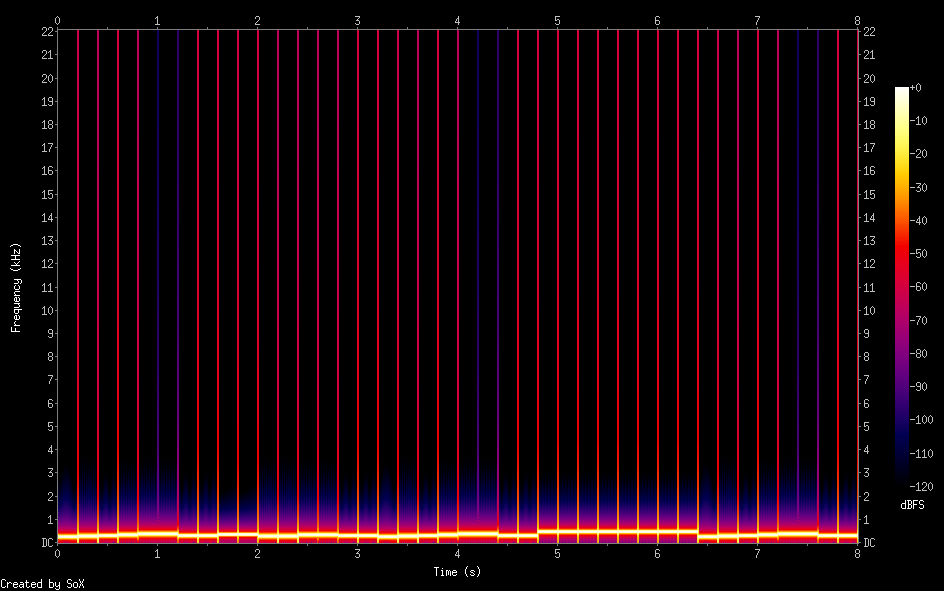Sound Bytes
A coding competition
Project maintained by coding-competitions Hosted on GitHub Pages — Theme by mattgraham
Inspecta Jelly
Listen
A crude attempt to write music in Jelly. Kinda like nailing jelly to a wall.
inspecta.jelly (UTF-8 version)
“¡ZP#QṢsẸ'ƒñ1Ị⁸¶6¦⁸G"ḥṇ[Œy!ðĠ=|-Ṅ⁺Kẋ~»;;⁾))ŒV
_49÷12 2*×440
⁽þEḶ÷122.×ǵ°ÆS
“')*,..**--)),,**')*,..**22222222')*,..**--)),,**3210////¡¡..3333‘Ç€F1Ŀ€
Explanation
Jelly is a ‘tacit’ programming language, meaning programs mostly consist of a sequence of operators that chain together to make more complicated operators, called ‘chains’ which can further be grouped together into ‘links’.
The program is composed of four ‘links’ that are used to generate a complete song.
-
The first link is responsible for formatting binary output:
“¡ZP#QṢsẸ'ƒñ1Ị⁸¶6¦⁸G"ḥṇ[Œy!ðĠ=|-Ṅ⁺Kẋ~»;;⁾))takes a single argument, let’s call itz, and returns a string formatted like this:import os,struct os.write(1,struct.pack("f",{z}))ŒVevaluates the previous result as Python code. -
The second link defines a method for computing the audio frequency of a given piano key. This is the main tool for interpreting the melody that will be defined later.
_49subtract 49 from the argument passed to this link.÷12divide the previous result by12(using floating-point division).2*raise 2 to the previous result.×440multiply the previous result by440In all, this is equivalent to the Python code:
def freq(z) = math.pow(2, (z - 49) / 12.0) * 440This equation was taken straight from Wikipedia.
-
The third link defines a method for generating a sine wave of a specific duration at a given frequency. This is the ‘synthesizer’ that will convert the given note to recognizable sound, although a sine wave is just about as simple as a synthesizer can get.
⁽þEis the constant value8820. This is the chosen length of a quarter note; at a sample rate of 44.1kHz, this equates to 200ms or ¹⁄₅ seconds.Ḷcreates a sequence from zero up to the previous result - 1, i.e.range(0, 8820). Note, because this is a sequence, all of the following operators automatically apply to every element of this sequence.÷122.divides the previous result by122.5×ǵapplies the second link to the argument then multiplies the previous result by this value.°multiplies the previous result sequence bypi / 180(converting degrees to radians).ÆSreturns the sine of the previous result.In all, this is roughly equivalent to the Python code:
def synth = [math.sin(x / 122.5 * freq(z) * math.pi / 180) for x in range(8820)] -
The last link is the main entry point of the program.
“')*,..**--)),,**')*,..**22222222')*,..**--)),,**3210////¡¡..3333‘creates a specific sequence of integers. This defines the ‘melody’ in terms of piano keys like so:melody = [39, 41, 42, 44, 46, 46, 42, 42, 45, 45, 41, 41, 44, 44, 42, 42, 39, 41, 42, 44, 46, 46, 42, 42, 50, 50, 50, 50, 50, 50, 50, 50, 39, 41, 42, 44, 46, 46, 42, 42, 45, 45, 41, 41, 44, 44, 42, 42, 51, 50, 49, 48, 47, 47, 47, 47, 0, 0, 46, 46, 51, 51, 51, 51]Ç€applies the third link to each element of the previous result, i.e. it creates an array of arrays representing sine waves for each note.Fflattens the previous result, into a single array.1Ŀ€applies the first link to each element of the previous result, i.e. it writes each value to stdout as binary.In all, this is equivalent to the python code:
for x in melody: for y in synth(x) output(y)
The rhythmic ‘popping’ noise is partially because each ‘note’ starts a brand new sine wave with no consideration of where the previous sine wave left off. This could be alleviated by having one single range for the whole melody instead of generating a separate range per note. It could also be reduced by multiplying the sine wave near the beginning or end of a note to fade the sound in or out more smoothly.
Language
Jelly
Golf Score
148
Parameters
| Sample Rate: | 44100 Hz |
| Sample Size: | 32 bits |
| Channels: | 1 (mono) |
| Encoding: | floating-point |
Commands
Run
jelly f inspecta.jellySpectrogram
